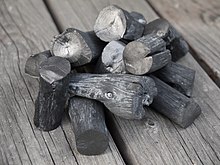Binchozumi
Binchōzumi or Binchōtan ( Japanese 備 長 炭 or also referred to as white charcoal ), also known as Binchō , is a type of charcoal that is obtained from the Asian stone linden oak Quercus phillyraeoides . The special charcoal is widely used for various types of preparation in Japanese cuisine, for example to fire grill ovens such as shichirin .
history
In the Edo period , at the end of the 17th century, binchōtan was first produced by the craftsman Bichū-ya Chōzaemon ( 備 中 屋 長 左衛 門 ) from the city of Tanabe . The wood of the stone linden oak , known in Japan as Ubame oak (Ubame-Gashi or Imame-Gashi), was used as the raw material. Today, Wakayama Prefecture produces high quality charcoal in large quantities, most of it from the city of Minabe , which produces more binchōtan than any other Japanese city.
Binchōtan is, since the name is not protected by trademark, also used for products made of white charcoal that are manufactured outside of Japan, for example in Vietnam . In order to differentiate itself from apparently inferior products from abroad, the white charcoal produced in Wakayama Prefecture is often called Kishū binchō-tan ( Kishū stands for the old name of Wakayama). Since the raw material of oak is becoming rarer and the profession of binchōtan charcoal burner is slowly dying out, the traditional binchōtan will become more expensive and less available in the next few years.
Manufacture and use
Binchōtan is a hardwood charcoal and is preferably used as charcoal. It is harder than normal charcoal and sounds slightly metallic when you tap it. The production is carried out at a very high temperature of around 1000 ° C with charring of pieces of wood. This creates a high-quality fuel that burns at a lower temperature than conventional charcoal, but gives off heat for a longer period of time, which is desirable for use in charcoal grills such as the Shichirin. The burning takes place without any noticeable odor development and it is often used in preparation methods such as yakiniku , where the grilled food such as eel or chicken does not take on a pronounced burnt taste.
Apart from being used as fuel, the coal can also be used as an adsorbent for chemicals. Similar to activated carbon , substances are caught in the small pores, for example, chlorine can be removed from tap water when cooking or odors can be drawn from rooms and wardrobes. There are textiles that use binchōtan as an odor trap, and the charcoal is also used in cosmetics . You can make wind chimes or musical instruments (the so-called tankin ) from the pieces of coal .
Web links
- Binchotan on materialarchiv.ch, accessed on December 26, 2017.
Video
Individual evidence
- ^ Artisanal Fuel. In: korin.com. Retrieved December 20, 2017 .
- ↑ Why do Chefs Prefer Kishû Binchôtan? (Japanese). In: bincho.jp. Retrieved December 20, 2017 .

